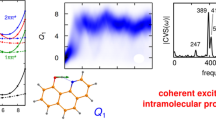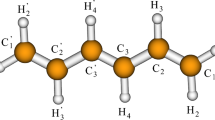Abstract
The ground and electronically excited singlet states of tetrahydrocannabinol have been studied theoretically using density functional and time-dependent density functional methods. The vertical excitation energies, the equilibrium geometries as well as the adiabatic excitation energies have been determined. Opening of the six-membered ring between the oxygen and carbon atoms has been considered as photochemical reaction path. This mechanism leads to a typical excited-state intramolecular hydrogen-transfer process and produces low-lying S 0–S 1 intersection (possible conical intersection, CI) which provides a channel for effective radiationless deactivation of the electronically excited state.





Similar content being viewed by others
Notes
Conical intersections (CIs), geometries where two electronic states are truly degenerate, providing a very efficient channel for nonradiative relaxation processes to the ground state on an ultrafast time scale with the extra energy being transformed into heat.
References
Gaoni Y, Mechoulam R (1964) J Am Chem Soc 86:1646
Mechoulam R, Gaoni Y (1967) Fortschr Chem Org Naturst 25:175
Agurell S, Dewey WL, Willette RE (1984) The cannabinoids: chemical, pharmacologic and therapeutic aspects. Academic Press, New York
Guzman M (2003) Nat Rev Cancer 3:745
Sarfaraz S, Adhami VM, Syed DN, Afaq F, Mukhtar H (2008) Cancer Res 868:339
Czifra G, Varga A, Nyeste K, Marincsák R, Tóth BI, Kovács I, Kovács L, Bíró T (2009) J Cancer Res Clin Oncol 135:507
Burns TL, Ineck JR (2006) Ann Pharmacother 40:251
Honório KM, Freitas LG, Trsic M, da Silva ABF (2001) J Mol Struct (Theochem) 538:99
Brogan AP, Eubanks LM, Koob GF, Dickerson TJ, Janda KD (2007) J Am Chem Soc 129:3698
Honório KM, da Silva ABF (2005) J Mol Model 11:200
Bodor NS, Huang MJ (1997) Int J Quant Chem 61:127
Huang MJ, Leszczynski J (2001) J Comp Aided Mol Des 15:323
Silva TB, Pereira MA, Malta VS, Bento ES, San-Miguel MA, Ziolli RL, Martins JBL, Sin A, Taft CA (2008) Int J Quant Chem 108:2530
Pate DW (1983) Econ Bot 37:396
Lydon J, Teramura AH (1987) Phytochemistry 26:1216
Lydon J, Teramura AH, Coffman CB (1987) Photochem Photobiol A 46:201
Köppel H, Domcke W, Cederbaum LS (1984) Adv Chem Phys 57:59
Worth GA, Cederbaum LS (2004) Annu Rev Phys Chem 55:127
Domcke W, Yarkony DR, Köppel H (2004) Conical intersections: electronic structure, dynamics and spectroscopy. World Scientific, Singapore. In particular see: (a) Yarkony DR, p 41; (b) Köppel H, p 175, (c) de Vivie- Riedle R Hofmann A, p 803
Handy NC, Tozer DJ (1999) J Comp Chem 20:106
Grabo T, Petersilka M, Gross EKU (2000) J Molec Struct (Theochem) 501:353
Guan J, Casida ME, Salahub DR (2000) J Molec Struct (Theochem) 527:229
Wanko M, Garavelli M, Bernardi F, Niehaus TA, Frauenheim T, Elstner M (2004) J Chem Phys 120:1674
Dreuw A, Head-Gordon M (2005) Chem Rev 105:4009
Levine BG, Ko C, Quennewille J, Martinez TJ (2006) Mol Phys 104:1039
Werner U, Mitric R, Suzuki T, Bonacic-Koutecky V (2008) Chem Phys 349:319
Sobolewski AL, Domcke W (1999) Phys Chem Chem Phys 1:3065
Ahlrichs R, Bar M, Haser M, Horn H, Kölmel C (1989) Chem Phys Lett 162:165. http://www.cosmologic.de
Schaftenaar G, Noordik JH (2000) J Comput Aid Mol Des 14:123
Schäfer A, Horn H, Ahlrichs R (1992) J Chem Phys 97:2571
Lee CT, Yang WT, Parr RG (1988) Phys Rev B 37:785
Klessinger M, Michl J (1995) Excited states and photochemistry of organic molecules, Sect. 4.3. VCH, Weinheim, USA
Sobolewski AL, Domcke W (2007) J Phys Chem A 111:11725
Sobolewski AL, Domcke W (2008) Chem Phys Lett 457:404
Formosinho SJ, Arnaut LG (1993) J Photochem Photobiol A 75:21
Douhal A, Lahmani F, Zewail AH (1996) Chem Phys 207:477
Sobolewski AL, Domcke W (2007) ChemPhysChem 8:756
Sobolewski AL, Domcke W (1994) Chem Phys 184:115
Sobolewski AL, Domcke W (1998) Chem Phys 232:257
Acknowledgments
A.V. acknowledges the OTKA Grant No. 80095 and the computational resources provided by the John-von-Neumann Institute, Research Centre Juelich (Project ID ehu01). The Leibniz Supercomputing Centre in Munich is also thanked for providing computational resources on the Linux Cluster.
Author information
Authors and Affiliations
Corresponding author
Additional information
Dedicated to Professor Sandor Suhai on the occasion of his 65th birthday and published as part of the Suhai Festschrift Issue.
Electronic supplementary material
Below is the link to the electronic supplementary material.
Rights and permissions
About this article
Cite this article
Halász, G.J., Sobolewski, A.L. & Vibók, Á. Radiationless decay of excited states of tetrahydrocannabinol through the S 1–S 0 (conical) intersection. Theor Chem Acc 125, 503–509 (2010). https://doi.org/10.1007/s00214-009-0673-2
Received:
Accepted:
Published:
Issue Date:
DOI: https://doi.org/10.1007/s00214-009-0673-2




